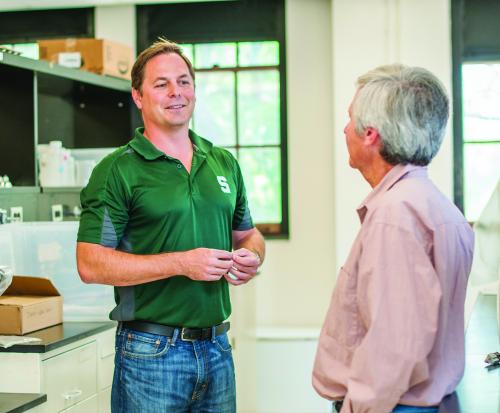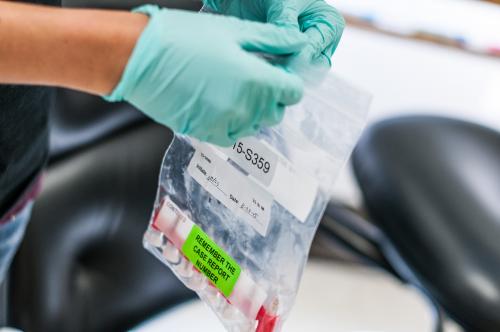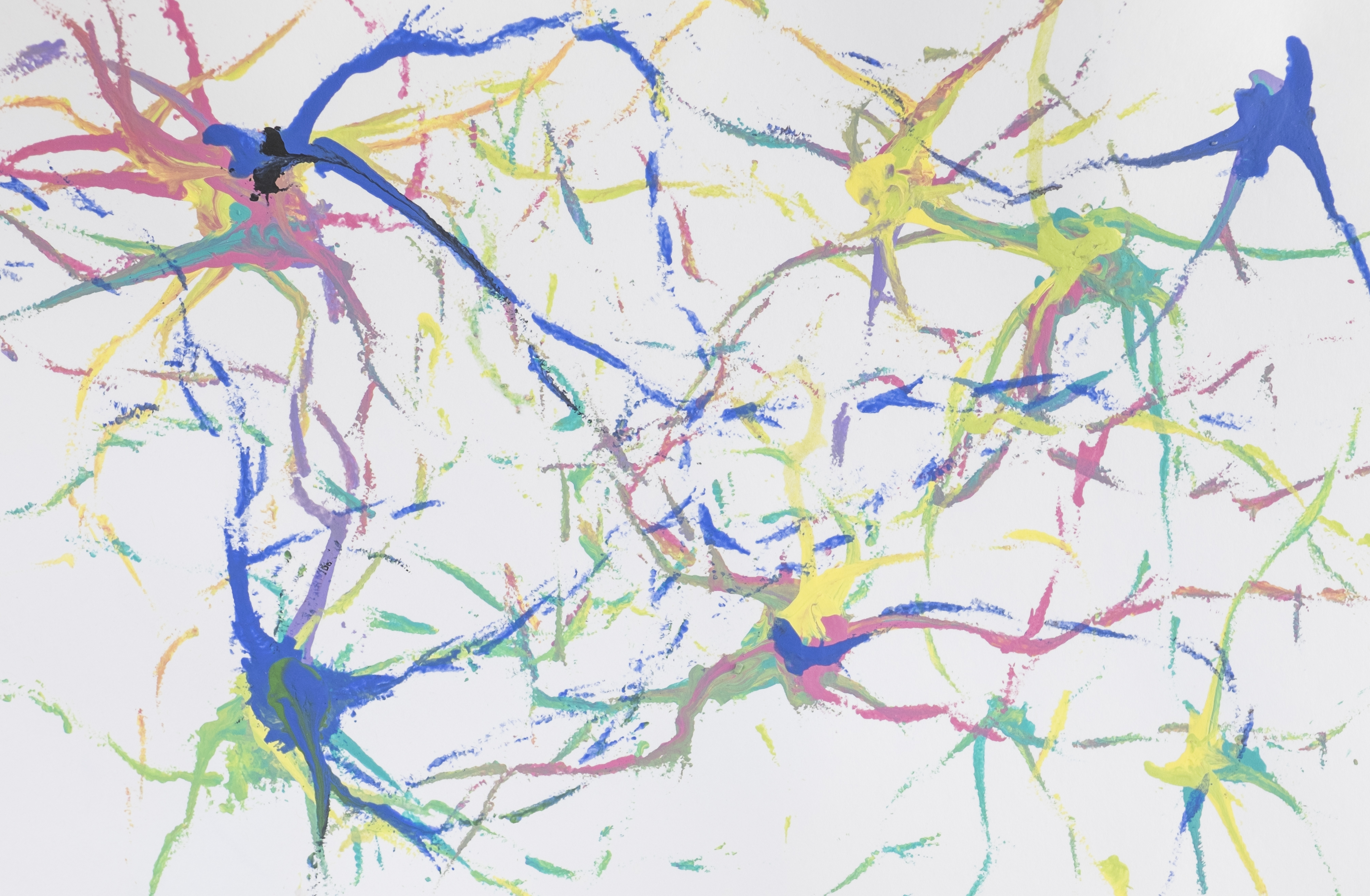Mystery solved, thanks to insects
MSU AgBioResearch entomologist Eric Benbow's laboratory research combines entomology and microbiology to solve mysteries. Read this and more in Futures magazine.

Nestled in the upper levels of Giltner Hall on Michigan State University’s (MSU) historic north campus, the laboratory of entomologist and osteopathic medical specialist Eric Benbow is home to cutting-edge research that blends entomology and microbiology to solve mysteries in areas as diverse as aquatic ecosystem dynamics and homicide investigations.
Visitors are greeted upon entry into the lab by small canvases emblazoned with chaotic streaks of paint -- artwork created by maggots -- along with a small Sparty statue. Graduate researchers and technicians bustle between the half of the lab that is covered in jars and dishes of preserved insects and the other, which hosts DNA extraction equipment. Inside a massive freezer labeled “DNA Only” is an impressive volume of cryoboxes – low-temperature storage containers housing microbial swabs from homicide victims. This content is an integral part of Benbow’s most recent research.
The microbiology of homicide
Benbow, who came to MSU in 2014, is partnering with Carl Schmidt, associate professor of pathology at the University of Michigan and Wayne County Medical Examiner, for a three-year project through a grant from the U.S. Department of Justice. He and his team are assisting death-scene investigators with the forensic analysis of homicide victims in Detroit. It has long been understood that the population dynamics of insects -- most notably, blowflies -- as a body changes during decomposition allow investigators to estimate time of death.
Benbow and his colleagues are endeavoring to apply those same principles to the necrobiome – the collection of microorganisms inside a dead body.
“After something dies, the microbial community within it changes,” Benbow said. “If we can understand how that community changes, and if we can find consistent patterns of change within it, then we may be able to use them to determine when a death occurred -- just like with insects.”
To determine those patterns, B enbow has to examine the population of not just one type of bacteria in the body but the entire microbial community. In humans, this comprises hundreds of species. The team is also maintaining a database of the findings, which is available to U.S. researchers and investigators to access and apply to their own work.
enbow has to examine the population of not just one type of bacteria in the body but the entire microbial community. In humans, this comprises hundreds of species. The team is also maintaining a database of the findings, which is available to U.S. researchers and investigators to access and apply to their own work.
Studying changes in the necrobiome of other species has implications for human cases. Courtney Weatherbee, a graduate student in the MSU Department of Entomology, spent the summer identifying patterns in the changing microbiome of dead pigs. The work, done in partnership with researchers at Purdue University, followed up on similar research conducted by Jennifer Pechal, a fixed-term assistant professor in the Department of Entomology. It entailed sampling six pig carcasses every 12 hours for both insect and microbial life in an effort to estimate time of death.
“The collaboration we have in the lab both between our own researchers and with those at other institutions is incredibly valuable,” Weatherbee said. “It allows us to pursue some pretty ambitious projects that have an impact on the world.”
Though Weatherbee has only begun to scratch the surface of the data she collected, preliminary findings suggest that the time of death can be accurately determined by measuring the microbial community. This adds an important line of evidence to Benbow’s work and validates Pechal’s previous study.
Adding another tool to the investigator’s crime scene repertoire, although a daunting task, will have far-reaching benefits in an era when juries increasingly expect genetic evidence in trials.
“We’ve seen -- through the influence of television shows such as ‘CSI’ -- where the characters can take a swab from a dead body and in the span of 45 minutes catch a killer. Jurors now have started demanding physical or chemical evidence as part of a prosecutor’s case,” Benbow explained. “When that isn’t available, I’ve been told by several prosecutors and expert witnesses that it’s much harder for them to make their case. We’re adding another avenue of evidence they can pursue at a crime scene.”
The ecological impact of death
The forensic efforts cross species lines, having implications well beyond homicides. Since 2013, through a partnership with the U.S. Department of Agriculture and Texas A & M University, Benbow has been studying the changing microbiome of dead salmon in streams near Juneau, Alaska.
In gathering data on how the microbial community changes over time as a salmon carcass decays, Benbow hopes to identify patterns that he can compare to those in other organisms, such as the humans involved in the Wayne County project. As commonalities appear, Benbow’s findings could be applied to other fields, such as natural resources management and law enforcement.
“If we can understand how the microbial community changes in a fish or a human, we can start to understand how it changes in a wide range of organisms,” Benbow said. “You could apply it to issues such as poaching. If the police find someone who has killed a bear, for example, and that person claims it charged and he/she shot it out of self-defense, the police coul d examine the bear’s microbiome to determine a time of death and whether the timeline of the suspect’s story is consistent with the evidence.”
d examine the bear’s microbiome to determine a time of death and whether the timeline of the suspect’s story is consistent with the evidence.”
Animal death also has an impact on the larger ecosystem. Courtney Larson, a doctoral student in the Benbow lab, is studying the impact of dead salmon on the stream ecology of Michigan’s northern Lower Peninsula. The project, which began in September 2014, examines the impact of salmon carrion on the development of stream biofilm. Biofilm, the slimy layer of microorganisms that forms around rocks and sediment in the streambed, performs a number of important functions in the stream ecosystem. It decomposes organic matter and serves as a significant food source for protozoa, invertebrates and small fish.
Larson studies the effect of salmon on biofilms by planting rectangular tiles in the streambed and allowing a biofilm to form around them. With the biofilm established, she deposits a dead salmon in the stream nearby and observes, over time, any changes that occur in the composition of the biofilm as a result of its access to the rich nutrients released by the decaying fish. Larson leaves the tiles in the stream for a full year, measuring changes in their biofilm at regular intervals.
“Working in the Benbow lab allows a lot of interdisciplinary collaboration and thought,” Larson said. “My project lets me combine my interest in aquatics with other disciplines of entomology such as forensics and carrion.”
The Benbow lab’s findings have the potential to benefit agriculture, as well.
“In the case of mega farms, where you have thousands of cattle in a herd, if the farmer loses even 5 percent of his animals in a season, and they are not rendered immediately, that adds up to a lot of dead bodies,” Benbow said. “Our work can tell them what will happen -- in terms of what insects and microorganisms could appear and in what numbers -- on their farm and make recommendations for how to dispose of the carcasses.”
Internationally known
The diverse and significant research conducted by Benbow’s team stands to change forensic science and natural resources management not just in Michigan but around the world. As a result, international scientists have been drawn toward the lab to participate in its groundbreaking work.
This past summer, the group started work with Philip Barton, an ecologist and research fellow from Australian National University in Canberra, Australia’s capital. Barton specializes in carrion ecology, focusing on the role of carrion in supporting biodiversity and the nutrient cycle in the ecosystem. Together, Benbow and Barton are working on a research project examining how insects alter the rate of decay of carrion in landscapes modified by human activity.
“Our work with Dr. Barton is addressing issues that have long been known but haven’t been thoroughly investigated,” Benbow said. “He came all the way here just to be able to spend a few days in our lab.”
is addressing issues that have long been known but haven’t been thoroughly investigated,” Benbow said. “He came all the way here just to be able to spend a few days in our lab.”
Australia is not the only far-flung locale from which Benbow’s collaborators hail. Guang-Hui Zhu is a visiting forensic entomologist with Shantou University’s Medical College in China’s southern Guangdong province. Zhu’s research focuses on studying the biochemistry of the puparium, the hard exoskeletal shroud that covers the final larval form of flies. As the larvae develop into adults and leave the corpse, their puparia are left behind.
“I’m exploring whether the puparium can be used to find the time of death,” Zhu explained. “Determining the time of death is crucial in any investigation, but it’s very difficult to do. I found a significant change in the hydrocarbon composition of the puparia as they age on the corpse, which may yield additional advantages to investigators.”
Zhu discovered that the hydrocarbons that make up much of the puparium’s structure decay at a predictable rate once it has been abandoned on the corpse. On the basis of this rate of decay, he is developing a method by which time of death can be estimated without the direct presence of the flies themselves.
Zhu met Benbow at an entomology conference in China in 2011 and quickly became interested in Benbow’s blend of entomology and microbiology to conduct forensic studies. By joining Benbow’s lab for a year, Zhu was able to utilize the resources and expertise of his teammates to study the effect of microbial life on the flies that were at the center of his own research.
Bringing research to the public
Despite the impressive findings and ambitious scope of his lab’s research, Benbow’s work would have relatively little impact if it remained sequestered in his corner of Giltner Hall. Fortunately, he and his team are actively engaged in bringing their research to life in academia and to the wider public.
Benbow co-edited two textbooks highlighting his lab’s research areas. Forensic Entomology: International Dimensions and Frontiers, published in March, unites the perspectives of entomologists from more than 20 countries spanning six continents in a discussion of the practical applications of entomological methods in forensic cases. Benbow also co-edited Carrion Ecology, Evolution and Their Applications, an overview textbook on the field of carrion ecology that was published in August.
“The carrion ecology book is more focused on basic science,” Benbow said. “When we’re looking at something that has died, we can study it to understand its life history and biological processes that continue to change it. Then we take that basic knowledge and show people how it can be applied in real-world scenarios.”
Benbow’s efforts are not limited, however, to writing textbooks for adults. The brightly colored painting that sits near the entrance of his lab is used as a key tool in teaching children about entomology.
 Maggots, the larval form of flies, go through three life stages before reaching adulthood. In the third and final stage, they begin to wander from their point of origin, seeking the dark, damp areas with which the popular imagination associates them. Benbow uses their abhorrence of the light as a way to illustrate their habits in demonstrations for elementary school classes. Dipping the maggots in paint, Benbow’s team releases them onto a white canvas and shines a bright light on them. As the maggots flee the light, they leave behind winding trails of brilliant color.
Maggots, the larval form of flies, go through three life stages before reaching adulthood. In the third and final stage, they begin to wander from their point of origin, seeking the dark, damp areas with which the popular imagination associates them. Benbow uses their abhorrence of the light as a way to illustrate their habits in demonstrations for elementary school classes. Dipping the maggots in paint, Benbow’s team releases them onto a white canvas and shines a bright light on them. As the maggots flee the light, they leave behind winding trails of brilliant color.
In addition to wowing the children, the lessons have a practical application.
“In a forensic context, maggots that wander from a wounded corpse may be covered in decomposition fluid,” Benbow explained. “They leave thin trails as they travel, and an investigator who is unfamiliar with this aspect of their behavior may mistake those trails for additional dried blood spatter, which leads to a misunderstanding of the crime scene.”
The greatest outreach effort, however, is helping bring closure to grieving families.
“As a scientist, you can do things that are just for science, just to understand nature,” Benbow said. “That’s important, and it keeps science going. But science also needs to be applied. I can use an insect to help bring closure to a family that is suffering loss, especially an untimely one, and bring justice to those circumstances. I know my work has contributed to more than just science -- it’s contributed to society, to humanity. Everyone in my lab has been a major part of this.”



 Print
Print Email
Email





